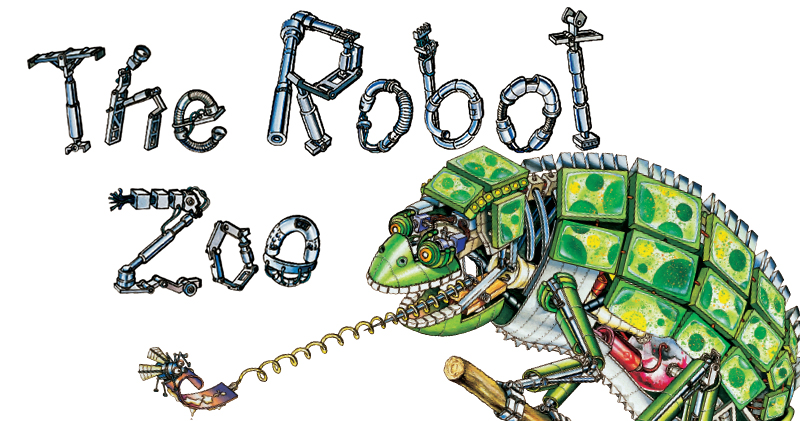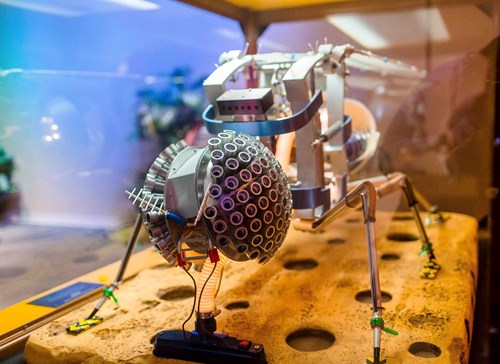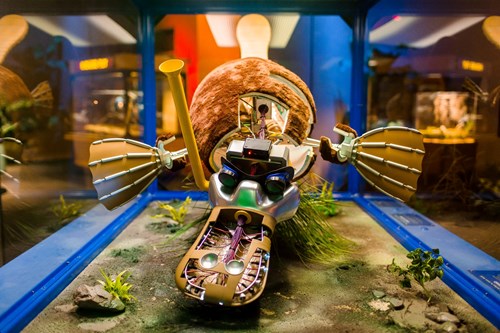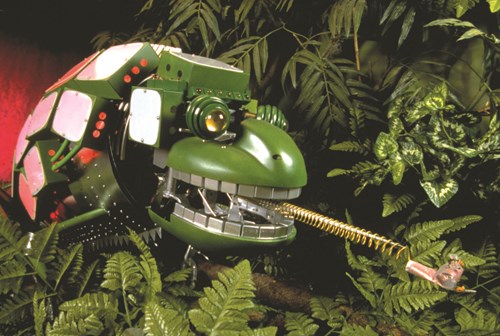3/2/2020 10:58:17 AM
By Sherry Lucas

Human ingenuity and cool animal perks come together in The Robot Zoo, a traveling exhibit that uses robot animals to explain the way some creatures’ remarkable adaptations work. Mississippi Department of Wildlife, Fisheries, and Parks’ (MDWFP) Mississippi Museum of Natural Science will play host to The Robot Zoo Jan. 18 through April 26.
The exhibit is based on the 1994 best-selling children’s book, “The Robot Zoo: A Mechanical Guide to the Way Animals Work.” It was first built in 1998 and extended 5,000 square feet. Two were created (one since sold to Singapore), says Cristi Klingelhefer, venue sales manager for Evergreen Exhibitions, which built and tours the exhibits. A smaller version came along in 2000 to fit smaller venues. With regular updates and refurbishments, The Robot Zoo has been touring ever since.
How can a fly walk on the ceiling or a chameleon change colors? The Robot Zoo shares the biomechanics behind it.
“What we’ve heard from museums is, ‘Everybody loves it.’ It’s one of those exhibits everybody can come to,” Klingelhefer says. “It’s educational, it’s fun, and it’s for so many different ages in the family.”
Designed for kids 4 and older, The Robot Zoo has school, group, and family appeal, and comes with a teacher activity guide.

The Robot Zoo coming to Jackson is the 2,500-square-foot version, and will allow kids to explore nature’s wonder as a master engineer, through the biomechanics of robot animals. The highly interactive display puts kids in control, pushing buttons to make the animals move.
It fits a winter-spring niche at the museum, for an engaging temporary addition to the permanent displays.
“We try and mix it up. We don’t want to just have dinosaurs, dinosaurs, dinosaurs,” says James Hill, public exhibits coordinator.
“We want to have a variation of themes and different messages from different exhibits. This one is more focused on the actual biology of animals,” he says, with unique, larger-than-life robot animals and a fair number of interactive parts — always a prime draw for temporary exhibits.
A suite of activities turn play into knowledge with hands-on fun for children. Animated robot animals of a chameleon, platypus, and housefly cover the range from exotic to common, and focus on characteristics so bizarre and super as to seem near-magical.
Animal body parts become machinery in their corresponding robot animals, where muscles are pistons, intestines are filtering pipes, and brains are computers. “The robot animals are meant to be a simplified way so kids can learn how animals move and eat,” Hill says. “Cool adaptations that animals have are shown in a robotic way to try and make it a little more obvious to kids.”
“There are cutaways, so you can see into the inner workings of the animals,” says Sam Beibers, exhibit supervisor, such as video screens on the side of a chameleon to show him changing color. Via joystick, kids can make the chameleon’s tongue zap out to hit a target.
“The Platypus (robot) shows he’s got a sensitive bill like a duck, and also how his legs work,” says Biebers. The housefly has a three-foot wingspan. Children can try their best to beat a pest that has a reaction time 12 times as fast as that of humans.
In the real world, the platypus likely counts as one of its strangest animals. “They’re what is called a monotreme,” Hill says. “They’ve got these weird little characteristics that no other mammals have.” In addition to the duck-like bill, they lay eggs, and adult males have a venomous spur.

“Chameleons have got these crazy eyes and weird tongues and houseflies are something that’s common but kind of super-powered, when you think about how quick their reactions are and how they can climb things,” Hill says.
Big, colorful robots, with plenty of buttons to push and things to watch, appeal to the young set. “That’s the first thing — getting the kids interested. And then, you might be able to teach them something,” Hill says.
“The robots themselves are the coolest thing, because they’re larger than life. The housefly is huge compared to the housefly you see zipping around,”
Klingelhefer says, and seeing the way they move mechanically “is pretty neat.”
The exhibit’s Robot Body Shop gives visitors a chance to manipulate devices used to build the robots, such as hinges, pumps, springs, and shock absorbers.
Other activities pull visitors into the robot animal’s world. For instance, on the chameleon you can see the following:
how the independently operating eyes view the world
how it sharpshoots “dinner” (insect targets) with the Tongue Gun
how it dons a coat that matches a wall, blends in, and “disappears”
Kids can build a platypus or their own whimsical creature with an assortment of body parts. On the housefly, get a fly’s eye view which might miss fine details but does not miss the slightest movement. Also, test reaction time by trying to “swat” the fly image as it randomly flashes (surely as frustrating as trying to swat houseflies in real life), and wear special hand pads to try and stick to a sloping surface the way flies can.

The exhibit’s creation predates the STEM education movement, but its robot animals and biomechanical focus make The Robot Zoo a natural fit with STEM studies.
The Robot Zoo can also offer a chance for children to consider, relatively speaking, what superpowers humans have.
“If we didn’t have a big brain, we’d get absolutely, figuratively, and literally eaten alive,” Hill says.
Tool-making abilities and strong familial bonds are other adaptations that enabled humans to “live past our weaknesses,” as exhibit supervisor Rachel Smart puts it.
“We’re good imitators, too,” Beibers says. “For example, a chameleon can change colors, but we’ve invented camouflage.”
“And, we’ve been using that for 100,000 years,” Smart says. “We figured that out early on. Also, our knees, our ankles — our bodies are built with shock absorbers all over.”
The Robot Zoo is included with museum membership or admission. Regular admission is $6 per adults, $4 per youth ages 3-18, $5 per senior citizens 60-plus, and free for children younger than 3 and museum members.
Sherry Lucas is a freelance writer for Mississippi Outdoors.



